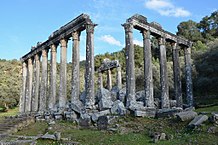| Εὔρωμος (in Greek) | |
 The Temple of Zeus Lepsinos at Euromus The Temple of Zeus Lepsinos at Euromus | |
 | |
| Alternative name | Eunomus, Eunomos, Kyromus, Hyromus |
|---|---|
| Location | Kızılcakuyu, Muğla Province, Turkey |
| Region | Caria |
| Coordinates | 37°22′27″N 27°40′31″E / 37.37417°N 27.67528°E / 37.37417; 27.67528 |
| Type | Settlement |
Euromus or Euromos (Ancient Greek: Εὔρωμος and Εὔροωμος) – also, Europus or Europos (Εὐρωπός), Eunomus or Eunomos (Εὔνωμος), Philippi or Philippoi (Φίλιπποι); earlier Kyromus and Hyromus – was an ancient city in Caria, Anatolia; the ruins are approximately 4 km southeast of Selimiye and 12 km northwest of Milas (the ancient Mylasa), Muğla Province, Turkey. It was situated at the foot of Mount Grium, which runs parallel to Mount Latmus, and was built by one Euromus, a son of Idris, a Carian.
History
Probably dating from the 6th century BC, Euromus was a member of the Chrysaorian League during Seleucid times. Euromus also minted its own coins from the 2nd century BCE to the 2nd century CE. Under the Roman dominion Euromus belonged to the conventus of Alabanda.
The ruins contain numerous interesting buildings, the most outstanding of which is the temple of Zeus Lepsinos from the reign of Emperor Hadrian.
Archaeology
Archaeologists have found terra cotta shards indicating that the temple site had its origins back at least to the 6th century BC. The temple is one of the best preserved classical temples in Turkey: sixteen columns remain standing and most of the columns are inscribed in honour of the citizen who commissioned their construction. Carian rock-cut tombs are also found at Euromus.
In July 2021, archaeologists led by Abuzer Kızıl have announced the discovery of two 2,500-year-old marble statues and an inscription during excavations at the Temple of Zeus Lepsynos. According to Abuzer Kızıl, one of the statues was naked while other was wearing armor made of leather and a short skirt. Both of the statues were depicted with a lion in their hands.
Gallery
References
- Dictionary of Greek and Roman Geography (1854), William Smith, Euromus
- Richard Talbert, ed. (2000). Barrington Atlas of the Greek and Roman World. Princeton University Press. p. 61, and directory notes accompanying. ISBN 978-0-691-03169-9.
- Strabo. Geographica. Vol. xiii. pp. 636, 658. Page numbers refer to those of Isaac Casaubon's edition.
- Stephanus of Byzantium. Ethnica. Vol. sub voce Εὔροωμος.
- Polybius. The Histories. Vol. 17.2.
- Livy. Ab urbe condita Libri [History of Rome]. Vol. 32.33, 33.30, 45.25.
- "Iasos - today it is called Kiyikislacik". bodrumpages.com.
- Pliny. Naturalis Historia. Vol. 5.28.
- 2,400-year-old tomb found in southwestern province
- Gershon, Livia. "Archaeologists in Turkey Unearth 2,500-Year-Old Temple of Aphrodite". Smithsonian Magazine. Retrieved 2021-08-31.
- "Two Statues and an Inscription Discovered in Turkey - Archaeology Magazine". www.archaeology.org. Retrieved 2021-08-31.
- "2,500-year-old statues, inscription unearthed in western Turkey". www.aa.com.tr. Retrieved 2021-08-31.
- "2,500-year-old statues, inscription unearthed in western Turkey". Hürriyet Daily News. Retrieved 2021-08-31.
![]() This article incorporates text from a publication now in the public domain: Smith, William, ed. (1854–1857). "Euromus". Dictionary of Greek and Roman Geography. London: John Murray.
This article incorporates text from a publication now in the public domain: Smith, William, ed. (1854–1857). "Euromus". Dictionary of Greek and Roman Geography. London: John Murray.
- Blue Guide, Turkey, The Aegean and Mediterranean Coasts (ISBN 0-393-30489-2), pp. 321–3
This article about a location in ancient Caria is a stub. You can help Misplaced Pages by expanding it. |
This geographical article about a location in Muğla Province, Turkey is a stub. You can help Misplaced Pages by expanding it. |
- Archaeological sites in the Aegean region
- Populated places in ancient Caria
- Ruins in Turkey
- Former populated places in Turkey
- Geography of Muğla Province
- History of Muğla Province
- Buildings and structures in Muğla Province
- Ancient Greek archaeological sites in Turkey
- Milas District
- Temples of Zeus
- Ancient Caria geography stubs
- Muğla Province geography stubs

